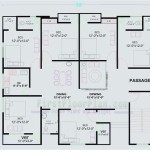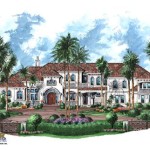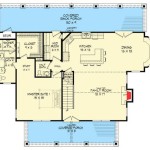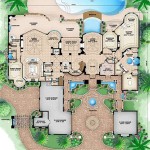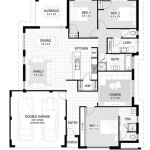Modern French Provincial House Plans: A Blend of Elegance and Function
Modern French Provincial house plans represent a compelling fusion of classic European charm and contemporary living requirements. These designs draw inspiration from the stately homes of the French countryside, characterized by their symmetrical facades, steeply pitched roofs, and a rustic architectural vocabulary. However, they adapt these traditional elements to suit modern lifestyles, incorporating open floor plans, energy-efficient technologies, and enhanced functionality. Understanding the nuances of this architectural style requires a consideration of its historical roots, distinguishing features, and the adaptations that define its modern interpretations.
The origins of French Provincial architecture can be traced back to the 17th and 18th centuries, when wealthy French families sought to emulate the grand chateaux of royalty but on a more modest scale. This regional style, therefore, reflects a desire for elegance and sophistication tempered by the practical considerations of rural life. These early homes were built using locally sourced materials, such as stone, brick, and stucco, and often featured symmetrical designs with balanced proportions. Over time, the style has evolved, embracing new materials and technologies while retaining its core aesthetic principles.
Modern French Provincial house plans strive to maintain the historical essence of the style while accommodating the demands of contemporary living. This often means incorporating larger windows for increased natural light, designing gourmet kitchens with state-of-the-art appliances, and creating luxurious master suites with spa-like bathrooms. The floor plans are generally open and flowing, promoting social interaction and facilitating efficient use of space. The architectural details, such as ornate moldings, arched doorways, and wrought-iron accents, are carefully selected to enhance the overall sense of refined elegance.
Key Features of Modern French Provincial Design
Several distinguishing characteristics define the Modern French Provincial style, setting it apart from other architectural genres. These features contribute to the overall aesthetic and create a sense of timeless elegance and understated sophistication.
Symmetry and Proportion: A hallmark of French Provincial architecture is its emphasis on symmetry and balanced proportions. The facade of the house typically features a central entry point flanked by matching windows and architectural details. This symmetry creates a sense of order and harmony, contributing to the overall visual appeal. The proportions of the house, including the height of the roof and the size of the windows, are carefully considered to achieve a balanced and pleasing aesthetic. While modern adaptations might introduce subtle asymmetries, the underlying principle of balance remains a crucial element.
Steeply Pitched Roofs: The steeply pitched roof is another defining characteristic of French Provincial homes. These roofs are often clad in slate or tile, adding to the overall sense of elegance and sophistication. The pitch of the roof is not merely aesthetic; it also serves a practical purpose, allowing for efficient drainage of rainwater and snow. Dormers, which are windows that project from the roof, are commonly incorporated into French Provincial designs, providing additional light and ventilation to the upper floors. These dormers often feature decorative details, such as arched tops or ornate moldings, further enhancing the architectural appeal.
Exterior Materials and Finishes: Modern French Provincial house plans often utilize a combination of natural and manufactured materials to create a textured and visually appealing exterior. Stucco is a common choice for the exterior walls, providing a smooth and durable finish. Stone accents, such as around the windows and doors, add a touch of rustic charm and visual interest. Brick can also be used, particularly in areas like chimneys or foundations. The color palette typically consists of muted tones, such as creams, beiges, and grays, which evoke a sense of understated elegance. Shutters, often painted in contrasting colors, add a touch of visual flair and enhance the overall curb appeal.
Adapting the Style for Modern Living
While maintaining the traditional aesthetic, Modern French Provincial house plans incorporate several adaptations to suit contemporary lifestyles. These adaptations focus on improving functionality, energy efficiency, and overall comfort.
Open Floor Plans: Traditional French Provincial homes often featured compartmentalized rooms, with each space serving a specific purpose. Modern interpretations, however, typically embrace open floor plans, creating a more fluid and interconnected living space. The kitchen, dining room, and living room are often combined into a single, open area, promoting social interaction and facilitating easy movement. This open layout is particularly well-suited for entertaining guests and accommodating family gatherings. The transition between spaces is often defined by changes in flooring or ceiling height, rather than by solid walls.
Gourmet Kitchens: The kitchen is the heart of the modern home, and Modern French Provincial house plans reflect this trend by incorporating gourmet kitchens with state-of-the-art appliances and ample counter space. These kitchens often feature custom cabinetry, high-end countertops (such as granite or marble), and professional-grade appliances. Islands are commonly included, providing additional workspace and seating. The design of the kitchen often incorporates elements of French Provincial style, such as ornate moldings, decorative hardware, and farmhouse sinks. The emphasis is on creating a functional and beautiful space that is both practical and aesthetically pleasing.
Luxurious Master Suites: Modern French Provincial house plans typically feature luxurious master suites that serve as private retreats for the homeowners. These suites often include spacious bedrooms, walk-in closets, and spa-like bathrooms. The bathrooms may feature features such as soaking tubs, walk-in showers, and double vanities. The design of the master suite often incorporates elements of French Provincial style, such as elegant lighting fixtures, decorative mirrors, and plush textiles. The goal is to create a comfortable and relaxing space that promotes rest and rejuvenation.
Sustainability and Energy Efficiency
Modern French Provincial house plans prioritize sustainability and energy efficiency, incorporating features that reduce environmental impact and lower utility bills. These features are seamlessly integrated into the design, ensuring that the house is both beautiful and environmentally responsible.
Energy-Efficient Windows and Doors: Energy-efficient windows and doors are essential for maintaining a comfortable indoor temperature and reducing energy consumption. Modern French Provincial house plans typically incorporate windows and doors that are designed to minimize heat loss in the winter and heat gain in the summer. These windows and doors often feature double or triple panes of glass, as well as low-E coatings that reflect solar radiation. Proper insulation around the windows and doors is also crucial for preventing air leaks and maximizing energy efficiency.
High-Efficiency HVAC Systems: High-efficiency heating, ventilation, and air conditioning (HVAC) systems are essential for maintaining a comfortable indoor environment while minimizing energy consumption. Modern French Provincial house plans often incorporate HVAC systems that are designed to be highly efficient, such as geothermal heat pumps or high-efficiency furnaces and air conditioners. Programmable thermostats allow homeowners to control the temperature in different zones of the house, further optimizing energy efficiency. Proper insulation throughout the house is also crucial for reducing the load on the HVAC system.
Sustainable Building Materials: Modern French Provincial house plans often utilize sustainable building materials, such as recycled wood, bamboo flooring, and low-VOC paints and finishes. These materials reduce environmental impact and improve indoor air quality. Sustainable landscaping practices, such as using native plants and installing rainwater harvesting systems, can also contribute to the overall sustainability of the house.
In conclusion, Modern French Provincial house plans provide a compelling blend of timeless elegance and contemporary functionality. By understanding the historical roots of the style, recognizing its distinguishing features, and embracing modern adaptations, homeowners can achieve a beautiful and comfortable living space that reflects their individual tastes and values. These homes offer a harmonious balance between classic charm and modern living, creating a welcoming and sophisticated environment for families to enjoy for generations to come. The integration of sustainable practices further ensures that these homes are not only beautiful but also environmentally responsible.

French Country Transitional Bainbridge Design Group

French Country House Plans Houseplans Blog Com
French Provincial Home Designs

French Country Transitional Bainbridge Design Group

Plan 41440 French Country House With Outdoor Kitchen

Beautiful French Country Style House Plan 8653 The Cobblestone

Plan 41435 Modern French Style Home

House Plan 4534 00038 French Country 2 350 Square Feet 4 Bedrooms 3 5 Bathrooms Plans Family Home Design Floor

One Story European Style House Plan 9977 Crescent

The French Quarter Madden Home Design Designer House


